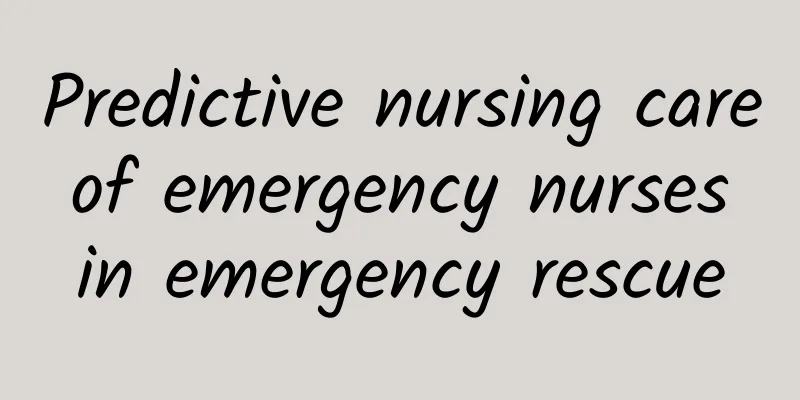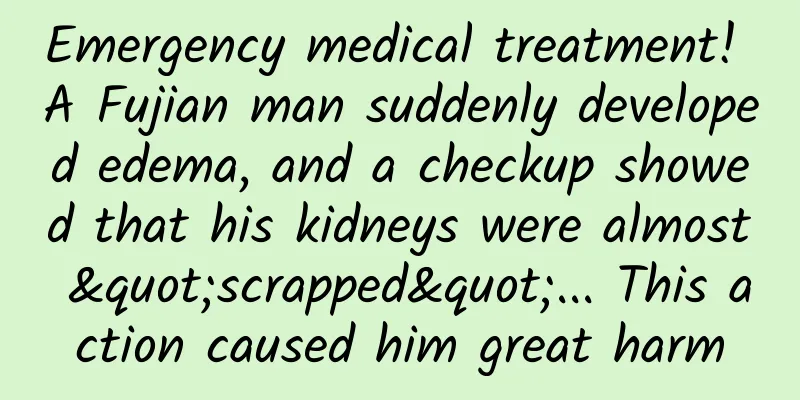Predictive nursing care of emergency nurses in emergency rescue

|
In the busy and tense emergency rescue work, emergency nurses play a vital role. They not only need to have solid medical knowledge and nursing skills, but also need to have keen predictive nursing thinking. Predictive nursing is based on a comprehensive assessment of the patient's condition and treatment, as well as the useful information obtained in the communication and interaction with the medical team, to conduct scientific analysis and prediction, so as to formulate and implement effective nursing measures in advance. 1. Accurate assessment of the condition is the prerequisite for predictive care Emergency rescue is time-sensitive and the condition is complex and changeable. Therefore, emergency nurses must have a high degree of professionalism and professionalism. After the patient enters the emergency room, the nurse must quickly and accurately assess the patient's condition. This includes detailed observation and recording of the patient's state of consciousness, pain level, breathing condition, skin color, pulse and other indicators. In addition, it is equally important to understand the patient's basic information and medical history, because this helps nurses quickly grasp the characteristics of the patient's condition and provide strong support for subsequent emergency measures. During the assessment process, emergency nurses also need to pay attention to the patient's psychological condition. Faced with sudden illness or injury, patients and their families often have panic, anxiety and other emotions. Therefore, in addition to providing professional care, nurses must also be good at communicating with patients and their families, soothing their emotions, and helping them build confidence in overcoming the disease. 2. Reasonable use of emergency equipment is the key to predictive care In emergency rescue, the rational use of various emergency equipment is crucial to saving patients' lives. Emergency nurses need to be proficient in the use of equipment such as ECG monitors, ventilators, and defibrillators, and quickly activate these devices when necessary. Taking the ECG monitor as an example, it can be used to observe the patient's ECG waveform and heart rate in real time, helping nurses determine whether the patient has problems such as arrhythmia. Nurses need to pay close attention to changes in the data displayed on the monitor. Once an abnormality is found, they should immediately notify the doctor and take appropriate measures. Similarly, the use of ventilators is also an indispensable part of emergency rescue. For patients with dyspnea or respiratory failure, the timely use of ventilators can effectively improve the patient's breathing condition and gain valuable time for subsequent treatment. 3. The role of predictive care in preventing complications Predictive care not only focuses on the treatment of the patient's current condition, but also strives to prevent possible complications. In emergency rescue, patients are often bedridden due to serious illness or treatment needs, which increases the risk of complications such as pressure sores and deep vein thrombosis. Therefore, emergency nurses need to turn patients over and massage them regularly to promote blood circulation and prevent complications. In addition, nurses also need to pay attention to patients' diet and nutritional status. For patients who cannot eat on their own, nurses need to assist patients in eating or provide enteral nutrition support; for patients who need to fast, nurses need to pay close attention to patients' electrolyte balance and nutritional status to ensure that patients receive reasonable nutritional support. 4. Teamwork and communication are the guarantee of predictive care In emergency rescue, nurses need to work closely with doctors, pharmacists, laboratory technicians and other personnel from multiple departments to provide patients with the best emergency plan. Nurses should promptly feedback to doctors information such as changes in the patient's condition and treatment response, and adjust nursing measures according to the doctor's instructions. At the same time, nurses must maintain good communication with personnel from other departments to ensure seamless connection of patients at different stages of treatment. Through teamwork and communication, not only can the success rate of emergency rescue be improved, but also the rescue time can be shortened, and more treatment opportunities can be gained for patients. In addition, information exchange between teams can also help nurses learn and accumulate more experience and knowledge, and improve their ability to provide predictive care. 5. Continuous learning and training are ways to improve predictive nursing capabilities With the continuous advancement of medical technology and the continuous updating of emergency care concepts, emergency nurses need to constantly learn and master new knowledge and skills. Hospitals should regularly organize nurses to participate in training on emergency care knowledge and skills, including training on the operation of emergency equipment, the use of emergency drugs, new emergency care techniques, etc. In addition, nurses should actively participate in academic exchanges and seminars, share experiences and insights with peers, and learn new nursing concepts and methods. Through continuous learning and training, nurses can improve their professional level and predictive nursing ability, and better provide patients with high-quality nursing services. VI. Conclusion Predictive care by emergency nurses in emergency rescue is a complex and important task. Through accurate assessment of the condition, rational use of emergency equipment, prevention of complications, teamwork and communication, and continuous learning and training, nurses can improve their predictive care capabilities and provide patients with safer and more effective emergency services. Author: Kong Lu, Qinhuangdao Hospital of Beijing University of Chinese Medicine Oriental Hospital (Qinhuangdao Traditional Chinese Medicine Hospital) |
<<: Protect your teeth by starting with the 'small things'!
>>: Teeth Whitening Tips: Scientific Methods and Daily Care
Recommend
Moxibustion chest acupoints
Breast care is very important for women, because ...
How long does it take for a woman to reach menopause?
Women will go through menopause when they reach a...
Why does a girl’s leucorrhea always turn yellow?
When women are still in their teenage years, they...
Can artificial insemination lead to ectopic pregnancy?
Many people do not know much about ectopic pregna...
A woman's body is sometimes hot and sometimes cold
Symptoms such as the body being hot and cold at t...
How to treat the symptoms of high male hormone levels in women
Nowadays, many women may have excessive androgen ...
The dominant follicle became smaller the next day.
The egg grows to a certain size, between 18mm and...
Can I still have sex after one month of pregnancy?
Generally, sexual intercourse is not recommended ...
Why does leucorrhea before menstruation appear as tofu residue?
Women often have leucorrhea before their period e...
What are the symptoms of miscarriage right after pregnancy?
Women face many risks during pregnancy, the most ...
How long can sperm survive outside the body?
How long can male sperm survive outside the body?...
What is the treatment for uterine inversion?
I believe that many women do not know what kind o...
How to maintain the uterus after abortion?
Everyone wants to be healthy. Abortion is the mos...
How to make beautiful women's breasts bigger
In today's society, many beautiful women care...









